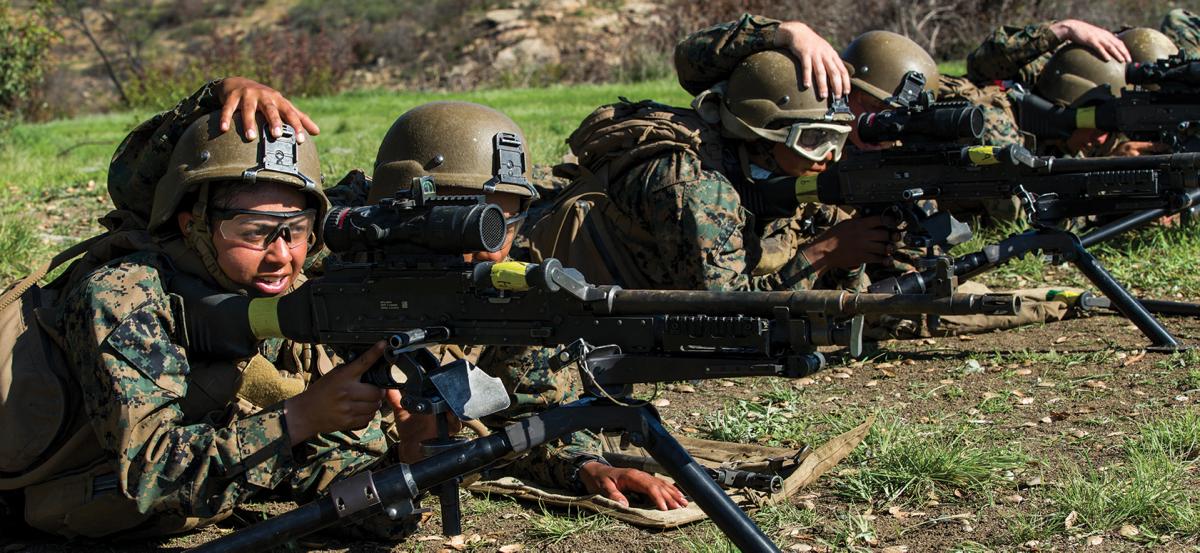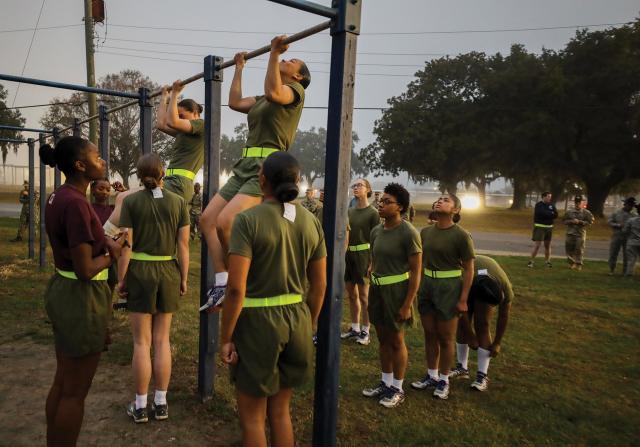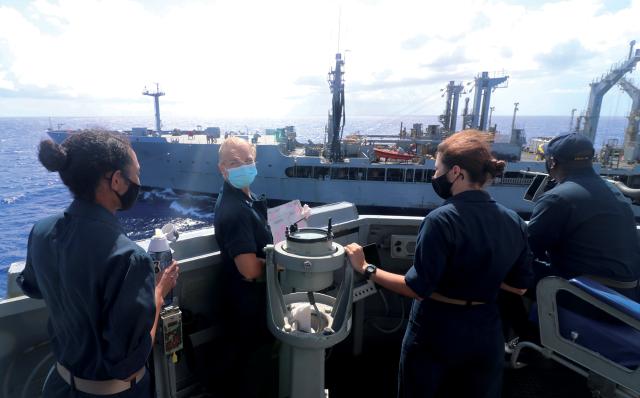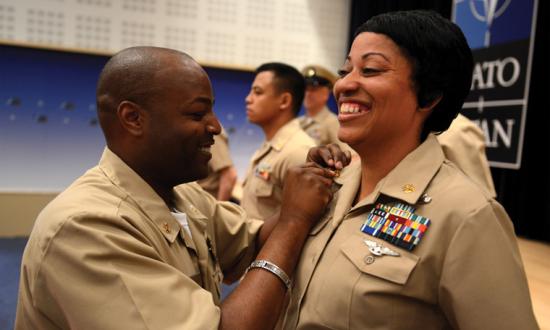Success in war demands results above all else, as the price of defeat is death or annihilation. To build an organization primed to win, the military must retain, promote, and select its top performers for the most demanding assignments. While the Department of the Navy prides itself on its principled meritocracy, too many of our best people do not stick around. Our best women, in particular, do not stick around.
The reasons many of these top performers transition to the civilian sector are many and varied. Some are outside the influence of the organization. Significant institutional barriers, however, make it far more difficult for female sailors and Marines to serve a full career in uniform.
At the heart of the problem is that our sisters-in-arms endure much more negative unit climates than our brothers-in-arms. Even worse, male service members are largely unaware of this disparity. This leadership problem is catalyzed by male leaders who are far less likely to mentor female subordinates than their male counterparts. At the same time, service-level policies create inappropriately different physical fitness standards for each gender, creating biases in male service members against female service members. If the Navy and Marine Corps aim to keep faith with all their people and allow for a full career of naval service—regardless of gender—leaders must act decisively to break down these obstacles.
Closing the Door On Trust
When I served as the Marine officer instructor (MOI) at a Naval Reserve Officers Training Corps (NROTC) unit, it was common for midshipmen to swing by during office hours for questions and counseling. Some of the most important mentoring opportunities arose during these times, as the mids were able to get one-on-one time with a company-grade officer, a position they hoped to soon hold.
I was sitting at my desk when one of the mids knocked on my hatch and poked his head in.
“Sir, do you have a minute?” His face, tone, and body language indicated some real concern.
I invited him in, and he closed the door, allowing for privacy. He relayed his issue, a potentially life altering one. As many of my Marines had endured similar challenges, I was able to speak with some knowledge and offer what I hoped was useful guidance. He left reassured. In time, he overcame his challenge and successfully commissioned.
A few days after that conversation, another mid knocked on my hatch and poked her head in. “Sir, you got a minute?” Her face, tone, and body language bespoke anxiety.
I invited her in. She closed the door.
I raised my hand. “Could you do me a favor and crack that door open?”
“Oh, sorry, sir. Sure thing,” she said, opening the door. The conversation was not as serious as I had anticipated, and she soon left.
In hindsight, I believe she did not disclose whatever was on her mind because she was not afforded the privacy to do so. If there was a challenge to overcome, she did, and she successfully commissioned. But it was not because of any guidance I provided. Even if there was no challenge to discuss that day, I had sent a clear and damaging message: “You and I will not have the same trust that your male counterparts and I do.”
As soon as this encounter ended, I realized I had erred terribly. I did not want to make the same mistake twice. I asked myself, “Why did I ask that the door stay open?”
That was an easy answer to find: “It is what my leaders taught me.” I had been warned countless times to avoid situations in which an outside observer might presume something inappropriate was going on, especially while interacting with a female service member. All it took was one investigation to end an otherwise promising career, and in my previous mentoring, precedents were trotted out like urban legends with moral lessons.1 Among other ways to ensure a “healthy transparency,” I had been taught a simple trick: Never be alone with a female service member, and if you have to be, keep the door open. So I did. And in so doing, I robbed a future officer of the things I owed her the most: leadership, mentoring, and trust.
This is just one story, but it is indicative of the obstacles that make it more difficult for female sailors and Marines to serve, discourage continued service, and, in turn, make the disproportion of female leaders at the most senior levels a self-fulfilling prophecy. While not exhaustive, the following challenges must be highlighted and addressed.
Enabling Absent Mentors
The phenomenon of men avoiding women in professional settings is confirmed by data collected from managers in the business world. A 2020 survey found that a stunning 60 percent of male managers are uncomfortable mentoring, socializing, or conducting one-on-one work-related activities with women.2 Motives are varied, but the predominant reason cited was fear of creating perceptions of impropriety that could lead to career repercussions. This fear aligns with the concern among male military leaders of being investigated for fraternization or being removed from their leadership position because of a loss of trust and confidence. These tendencies become reinforced by the system itself. The same senior leaders who taught their male subordinates discretionary avoidance of female service members likely hold the same view, and their exercise of military discipline will be informed by that same bias.
The professional cost of a lack of mentors is staggering, and it disproportionately affects women. Studies of mentoring behavior reveal that effective mentors are far more than a source of guidance and rudder steer. Mentors become de facto sponsors who work diligently to get “their” high-performing people promoted or assigned to high-visibility positions with the most growth potential.3 In the Navy, this aspect of mentoring has been described as having a “sea daddy”—someone who provides career development and advocacy—and was examined in depth in a 2015 Naval War College study.4
While the study found little evidence of cronyism, the functions of career advocacy, teacher/trainer, and career adviser were paramount, and often remained present years after the circumstances that had birthed the mentor/protégé relationship.5 This form of advocacy becomes more critical as one grows in seniority. It is no secret that name recognition carries weight in any board room. Given the significance of mentoring to career longevity and success, it is immediately apparent that the reluctance of male senior leaders to mentor female subordinates sets women up for a decisive professional disadvantage, discouraging the conditions for a lifelong career in the naval service.
Feeding Bias with Divergent Standards
Men and women are physically different. Some of these differences must necessarily be accounted for in service policy, such as allowances for maternity leave. Sea Service physical training standards, however, only reinforce misogyny by creating lower standards for women than men.
The Marine Corps physical fitness test (PFT) and combat fitness test (CFT), along with the Navy’s physical readiness test (PRT), assess physical fitness and are used as quantifiable inputs to promotion systems and fitness reports. Each has different scoring systems for men and women, such that women can achieve higher scores than men while executing a lower physical output. For example, a male Marine in the 17–20 age group must perform 20 pull-ups to earn 100 points on that portion of the PFT, while a female Marine in the same age group must only perform 7 for the same score.6 At the start of their careers, this sends an immediate message to young male Marines: Women can do less and get more. This perception can lead to undesirable and unhealthy conclusions, such as that women are not as good as men and cannot succeed without a leg up. This only feeds further biases.7
The simplest way to remove the source of this bias is to create gender-neutral scores for all members in each service. Some speculate that this would mean either lowering fitness standards for men or making fitness standards for women so high that they would fail to meet them.8 Concerns with female performance fail to account for the history of military fitness tests, which repeatedly have been toughened, only to see members improve and rise to the occasion each time.9 Of note, female Marines used to have to run only 1.5 miles during the PFT, but they must now run 3 miles, the same as their male counterparts. The same debates occurred when the standard changed, and arguments against the increase were proved unfounded. In small units across each service, when leaders demand more and provide subordinates the tools to succeed, they succeed. The physical training principles of progressive overload remain constant, and with time and effort, most service members can excel at their fitness tests, regardless of gender.10
Recognizing Blind Spots
The Marine Corps touts its institutional progress, as all previously closed occupational fields are now open to women. The service is finally integrating men and women at recruit training.11 Too many leaders are focused on how things are improving. They believe that as long as naval leaders discipline outliers who harass or demean their sisters-in-arms, there is little more to worry about. This tendency to declare victory leaves a blind spot. Assessments as to whether command climates truly are inclusive depend on who you ask. The answers break down along gender lines.
The Department of Defense’s (DoD’s) 2019 Annual Report on Sexual Assault in the Military, which surveyed men and women across the ranks from each service, identifies that male service members are far less likely to recognize gender-based discrimination than their female peers.12 Meanwhile, the 2018 Workplace and Gender Relations Survey of Active Duty Members shows that women rate every aspect of the unit climate significantly lower, and the level of workplace hostility as significantly higher, than men.13 This corresponds with research on male and female perceptions in the corporate world, which found 82 percent of women feel some form of exclusion, while 92 percent of men do not believe they are excluding women.14
Such blind spots occur in every instance of human group differentiation, but that does not mean they should be discounted; rather, they should be accounted for and engaged. These blind spots are clearly captured in DoD surveys year after year. It is incumbent on male leaders to acquaint themselves with this information to build awareness, so that the disparities in male and female experiences of service life can be accounted for, from writing service policy to actions at the platoon and division levels.
Close the Doors
While the Navy and Marine Corps have made significant strides in recent years to allow for a more integrated and inclusive force, more work is needed to remove the significant challenges female service members face that discourage full careers. These are barriers that can, and must, be broken down by decisive leadership across the Sea Services.
Male leaders, first and foremost, must overcome their reluctance to offer the same mentorship to women as to men. Rather than discouraged as a career-endangering risk, male and female interaction should be encouraged by leaders at the highest levels and normalized; the phrase “perception is reality” should be contextualized and not thrown around as a bogeyman.
Ending gender-specific physical-training standards—practices that can sow the seeds of misogyny, harassment, and discrimination—will go a long way toward eliminating gender barriers that are obvious to female service members, yet can seem invisible to their male counterparts. Setting readiness standards grounded in tried-and-true physical training principles will allow all service members to excel. Male leaders at every echelon must familiarize themselves with annual survey data regarding differences in male and female perceptions of unit climate and address the challenges raised by our sisters-in-arms.
In the past, Sea Service leaders have “kept the door open” in a misguided attempt to protect themselves. Instead, we must build trust through a willingness to close the door, allowing female sailors and Marines the same opportunities for success throughout their careers in the naval service.
1. Carl Rosenberg, “A Marine Colonel Was Drugged in a Bogota Pub, Then Robbed. Now He’s Forced to Retire,” Miami Herald, 30 January 2018.
2. Courtney Connley, “60% of Male Managers Now Say They’re Uncomfortable Participating in Work Activities with Women,” CNBC, 17 May 2019.
3. Kimberly Weisul, “Why Mentoring Helps Men More Than Women,” CBS News, 25 March 2011.
4. W. Brad Johnson and Gene R. Andersen, “Mentoring in the U.S. Navy: Experiences and Attitudes of Senior Navy Personnel,” Naval War College Review 68, no. 3 (Summer 2015): 8.
5. Johnson and Andersen, “Mentoring in the U.S. Navy,” 6.
6. Headquarters, Marine Corps, MCO 6100.13A CH-2: Marine Corps Physical Fitness and Combat Fitness Tests (Washington, DC: HQMC, 2019), 2–10.
7. Under Secretary of Defense for Personnel and Readiness, Annual Report on Sexual Assault in the Military (Washington, DC: Department of Defense Sexual Assault Prevention and Response, 2020), 12–13.
8. Jeff Schogol, “New Concerns That Lower Fitness Standards Fuel Disrespect for Women,” Marine Corps Times, 21 May 2017.
9. Andrew Thompson, “Physical Fitness in the United States Marine Corps: History, Current Practices, and Implications for Mission Accomplishment and Human Performance,” thesis (Naval Postgraduate School, December 2005).
10. Jeff Schogol, “The PFT and CFT Can Be Gender Neutral. Here’s How,” Marine Corps Times, 10 July 2017.
11. Philip Athey, “Marines Lay Out Plans for Gender Integrating Boot Camp at the Platoon Level,” Marine Corps Times, 1 September 2020.
12. Under Secretary of Defense for Personnel and Readiness, Annual Report on Sexual Assault in the Military, 12.
13. Rachel Breslin et al., 2018 Workplace and Gender Relations Survey of Active Duty Members (Alexandria, VA: Office of People Analytics, 2019), xii.
14. Susan Adams, “8 Blind Spots between the Sexes at Work,” Forbes, 26 May 2013.








